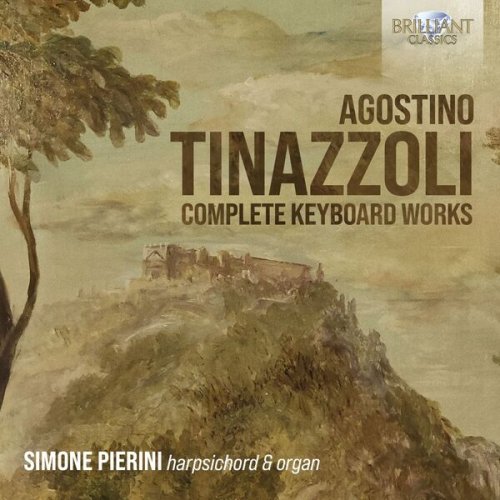
Simone Pierini - Tinazzoli: Complete Keyboard Works (2023)
BAND/ARTIST: Simone Pierini, Simone El Oufir Pierini
- Title: Tinazzoli: Complete Keyboard Works
- Year Of Release: 2023
- Label: Brilliant Classics
- Genre: Classical
- Quality: FLAC (tracks + booklet)
- Total Time: 1:30:39
- Total Size: 473 MB
- WebSite: Album Preview
Tracklist:
1. Toccata No. 17: I. Allegro (04:04)
2. Toccata No. 17: II. Grave. Arpeggio - Prestissimo - Adagio (01:50)
3. Toccata No. 17: III. Affettuoso (01:34)
4. Toccata No. 18: I. Allegro (03:50)
5. Toccata No. 18: II. Suo balletto (01:15)
6. Sonata No. 12: I. Eelevatione. Adagio (05:24)
7. Capriccio No. 3: I. Presto (03:17)
8. Capriccio No. 3: II. Adagio (01:01)
9. Capriccio No. 3: III. Minuet. Allegro (01:43)
10. Toccata No. 6: I. Allegro (02:32)
11. Capriccio No. 16: I. Allegro (02:13)
12. Capriccio No. 7: I. Allegro (04:24)
13. Sonata No. 5: I. Offertorio (04:10)
14. Capriccio No. 14: I. Allegro (03:17)
15. Capriccio No. 14: II. Adagio - Allegro (02:02)
16. Capriccio No. 9: I. Allegro (02:22)
17. Capriccio No. 10: I. Allegro (02:11)
18. Sonata No. 13: I. Post agnus. Allegro (03:55)
19. Sonata No. 4: I. Allegro (03:21)
20. Sonata No. 4: II. Sarabanda (02:13)
21. Sonata No. 4: III. Allegro (02:45)
22. Sonata No. 2: I. Allegro (03:13)
23. Partite sopra il passagallo (07:51)
24. Sonata No. 11: I. Offertorio. Allegro (04:38)
25. Sonata No. 8: I. Allegro (03:47)
26. Sonata No. 1: I. Adagio (01:26)
27. Sonata No. 1: II. Allegro (02:42)
28. Sonata No. 1: III. Largo (00:47)
29. Sonata No. 1: IV. Prestissimo arpeggiato - Adagio (01:07)
30. Sonata No. 1: V. Allegro (02:23)
31. Capriccio No. 15: I. Allegro (03:07)
1. Toccata No. 17: I. Allegro (04:04)
2. Toccata No. 17: II. Grave. Arpeggio - Prestissimo - Adagio (01:50)
3. Toccata No. 17: III. Affettuoso (01:34)
4. Toccata No. 18: I. Allegro (03:50)
5. Toccata No. 18: II. Suo balletto (01:15)
6. Sonata No. 12: I. Eelevatione. Adagio (05:24)
7. Capriccio No. 3: I. Presto (03:17)
8. Capriccio No. 3: II. Adagio (01:01)
9. Capriccio No. 3: III. Minuet. Allegro (01:43)
10. Toccata No. 6: I. Allegro (02:32)
11. Capriccio No. 16: I. Allegro (02:13)
12. Capriccio No. 7: I. Allegro (04:24)
13. Sonata No. 5: I. Offertorio (04:10)
14. Capriccio No. 14: I. Allegro (03:17)
15. Capriccio No. 14: II. Adagio - Allegro (02:02)
16. Capriccio No. 9: I. Allegro (02:22)
17. Capriccio No. 10: I. Allegro (02:11)
18. Sonata No. 13: I. Post agnus. Allegro (03:55)
19. Sonata No. 4: I. Allegro (03:21)
20. Sonata No. 4: II. Sarabanda (02:13)
21. Sonata No. 4: III. Allegro (02:45)
22. Sonata No. 2: I. Allegro (03:13)
23. Partite sopra il passagallo (07:51)
24. Sonata No. 11: I. Offertorio. Allegro (04:38)
25. Sonata No. 8: I. Allegro (03:47)
26. Sonata No. 1: I. Adagio (01:26)
27. Sonata No. 1: II. Allegro (02:42)
28. Sonata No. 1: III. Largo (00:47)
29. Sonata No. 1: IV. Prestissimo arpeggiato - Adagio (01:07)
30. Sonata No. 1: V. Allegro (02:23)
31. Capriccio No. 15: I. Allegro (03:07)
The pieces presented here are ascribed to a composer whose life appears to be both mysterious and adventurous at the same time: little of Agostino Tinazzoli (ca 1660-1725) is known, as concerns biographical details such as his living places, his teachers, and the job positions he held. However, some unusual facts preserved through his music make clear that this composer probably had no ordinary life: during his stay in Rome he probably committed, or was involved, in an unspecified crime: for this reason, he got incarcerated in Castel Sant’Angelo, Rome, which during Tinazzoli’s time was partly used as a city jail. Here he continued to compose: his cantata “In Carcere penoso” was written with carbon on the prison wall, and its beauty prompted his immediate release from jail. • This collection of Tinazzoli’s keyboard music employs a wide range of styles and formal structures: we have concerto-like pieces (Toccata No.17, Sonata no. 4), as well as fugato pieces (Sonata No.11), and dance movements (the Sarabanda in Sonata No.4). The most important feature of these pieces, however, is the massive employment of basso continuo: the pieces are almost everywhere notated in two voices (treble and bass), but continuo numeration is employed everywhere. This means that the performer has to add other voices, or remove them in order to make dynamic effects, and sometimes even to improvise counterpoint, according to stylistic continuo rules in early 18th century’s Italy. • Born in Rome in 1996, Simone Pierini began studying music at the age of eight. Aged eighteen, he graduated in piano at S. Cecilia Conservatory of Music, Rome, with highest honors, and consequently took part in masterclasses and post-graduate courses. He afterwards grew interest in historically informed piano practice, attending masterclasses led by Alexei Lubimov, Andreas Staier, Tobias Koch, Stefano Fiuzzi. Subsequently, his interest about historical keyboards in general grew further, and he began studying harpsichord and basso continuo with such teachers as Andrea Coen and Giovanni Togni. He builds an active concert career.
Year 2023 | Classical | FLAC / APE
As a ISRA.CLOUD's PREMIUM member you will have the following benefits:
- Unlimited high speed downloads
- Download directly without waiting time
- Unlimited parallel downloads
- Support for download accelerators
- No advertising
- Resume broken downloads


